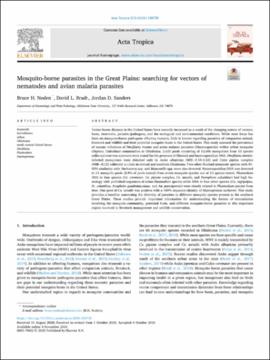| dc.contributor.author | Noden, Bruce H. | |
| dc.contributor.author | Bradt, David L. | |
| dc.contributor.author | Sanders, Jordan D. | |
| dc.date.accessioned | 2022-04-12T13:50:59Z | |
| dc.date.available | 2022-04-12T13:50:59Z | |
| dc.date.issued | 2021 | |
| dc.identifier | oksd_noden_mosquitoborneparasites_2021 | |
| dc.identifier.citation | Noden, B. H., Bradt, D. L., & Sanders, J. D. (2021). Mosquito-borne parasites in the Great Plains: Searching for vectors of nematodes and avian malaria parasites. Acta Tropica, 213, Article 105735. https://doi.org/10.1016/j.actatropica.2020.105735 | |
| dc.identifier.uri | https://hdl.handle.net/11244/335176 | |
| dc.description.abstract | Vector-borne diseases in the United States have recently increased as a result of the changing nature of vectors, hosts, reservoirs, parasite/pathogens, and the ecological and environmental conditions. While most focus has been on mosquito-borne pathogens affecting humans, little is known regarding parasites of companion animal, livestock and wildlife and their potential mosquito hosts in the United States. This study assessed the prevalence of mature infections of Dirofilaria immitis and avian malaria parasites (Haemosporida) within urban mosquito (Diptera, Culicidae) communities in Oklahoma. 2,620 pools consisting of 12,686 mosquitoes from 13 species collected over two summers were tested for the presence of filarioid and haemosporidian DNA. Dirofilaria immitis-infected mosquitoes were detected only in Aedes albopictus (MIR=0.18-0.22) and Culex pipiens complex (MIR=0.12) collected in cities in central and southern Oklahoma. Two other filarioid nematode species with 91-92% similarity with Onchocerca spp. and Mansonella spp. were also detected. Haemosporidian DNA was detected in 13 mosquito pools (0.9% of pools tested) from seven mosquito species out of 13 species tested. Plasmodium DNA in four species (Cx. coronator, Cx. pipiens complex, Cx. tarsalis, and Psorophora columbiae) had high homology with published sequences of avian Plasmodium species while DNA in four other species (Cx. nigripalpus, Ps. columbiae, Anopheles quadrimaculatus, and An. punctipennis) were closely related to Plasmodium species from deer. One pool of Cx. tarsalis was positive with a 100% sequence identity of Haemoproteus sacharovi. This study provides a baseline concerning the diversity of parasites in different mosquito species present in the southern Great Plains. These studies provide important information for understanding the factors of transmission involving the mosquito community, potential hosts, and different mosquito-borne parasites in this important region involved in livestock management and wildlife conservation. | |
| dc.format | application/pdf | |
| dc.language | en_US | |
| dc.publisher | Elsevier BV | |
| dc.relation.ispartof | Acta Tropica, 213 | |
| dc.relation.uri | https://www.ncbi.nlm.nih.gov/pubmed/33159896 | |
| dc.rights | This material has been previously published. In the Oklahoma State University Library's institutional repository this version is made available through the open access principles and the terms of agreement/consent between the author(s) and the publisher. The permission policy on the use, reproduction or distribution of the material falls under fair use for educational, scholarship, and research purposes. Contact Digital Resources and Discovery Services at lib-dls@okstate.edu or 405-744-9161 for further information. | |
| dc.subject.mesh | Aedes | |
| dc.subject.mesh | Animals | |
| dc.subject.mesh | Anopheles | |
| dc.subject.mesh | Birds | |
| dc.subject.mesh | Culex | |
| dc.subject.mesh | Culicidae | |
| dc.subject.mesh | Deer | |
| dc.subject.mesh | Dirofilaria immitis | |
| dc.subject.mesh | Filarioidea | |
| dc.subject.mesh | Haemosporida | |
| dc.subject.mesh | Humans | |
| dc.subject.mesh | Malaria, Avian | |
| dc.subject.mesh | Mosquito Vectors | |
| dc.subject.mesh | Oklahoma | |
| dc.subject.mesh | Plasmodium | |
| dc.title | Mosquito-borne parasites in the Great Plains: Searching for vectors of nematodes and avian malaria parasites | |
| dc.date.updated | 2022-04-07T14:07:26Z | |
| osu.filename | oksd_noden_mosquitoborneparasites_2021.pdf | |
| dc.description.peerreview | Peer reviewed | |
| dc.identifier.doi | 10.1016/j.actatropica.2020.105735 | |
| dc.description.department | Entomology and Plant Pathology | |
| dc.type.genre | Article | |
| dc.type.material | Text | |
| dc.subject.keywords | Dirofilaria | |
| dc.subject.keywords | Haemoproteus | |
| dc.subject.keywords | Oklahoma | |
| dc.subject.keywords | Plasmodium | |
| dc.subject.keywords | Surveillance | |
| dc.subject.keywords | south central United States | |
| dc.subject.keywords | urban | |
| dc.subject.keywords | Genetics | |
| dc.subject.keywords | Rare Diseases | |
| dc.subject.keywords | Vector-Borne Diseases | |
| dc.subject.keywords | Emerging Infectious Diseases | |
| dc.subject.keywords | Infectious Diseases | |
| dc.subject.keywords | Malaria | |
| dc.subject.keywords | Prevention | |
| dc.subject.keywords | 2.2 Factors relating to the physical environment | |
| dc.subject.keywords | Infection | |
| dc.subject.keywords | 3 Good Health and Well Being | |
| dc.subject.keywords | 06 Biological Sciences | |
| dc.subject.keywords | 11 Medical and Health Sciences | |
| dc.subject.keywords | Tropical Medicine | |
| dc.identifier.author | ORCID: 0000-0002-0096-370X (Noden, BH) | |
| dc.identifier.author | ScopusID: 6601968347 (Noden, BH) | |
| dc.identifier.author | ORCID: 0000-0001-9693-581X (Bradt, DL) | |
| dc.identifier.author | ScopusID: 57193879068 (Bradt, DL) | |
| dc.identifier.author | ScopusID: 57219378685 (Sanders, JD) | |
